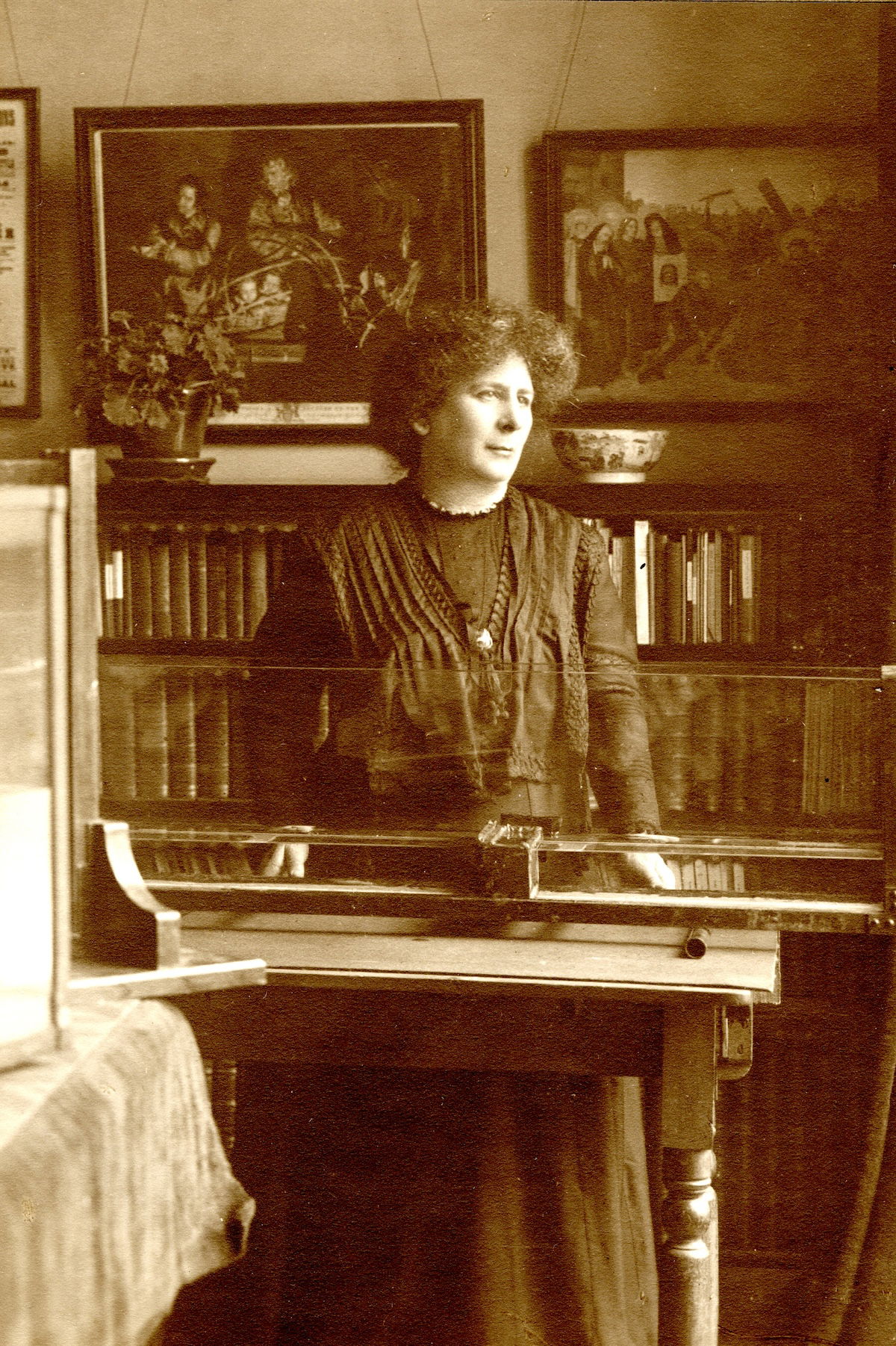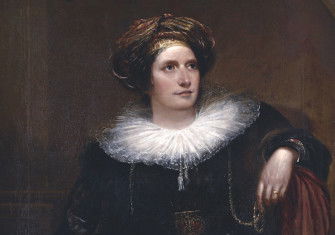How Hertha Ayrton Made Waves
Hertha Ayrton’s experiment in a bathtub may have saved lives in the trenches, but it caused ripples among the ranks of the Royal Society.

In 1903 the physicist William Ayrton was so worn down by chronic depression that he retreated to Margate for a three-month rest cure. Much as she adored him, his wife Hertha soon tired of strolling at his side around the beautiful bay. An avid inventor, she had nearly finished writing her definitive book, The Electric Arc, about electric lighting, but – like many authors – she kept avoiding that tiresome task of finalising the details. High time, she decided, for a more exciting project.
On her return from the beach one afternoon she startled her landlady by demanding that a zinc bath, along with soap dishes, pudding basins, and sundry other household containers, be supplied. During her daily walks she had become fascinated by the sand ripples that repeatedly formed beneath the waves, only to be washed away by the retreating tide. Before long her miniature model sea in the zinc bath provided convincing evidence that the standard account given by George Darwin, Charles Darwin’s second son, was wrong. Whereas he maintained that each sand ripple was created separately, she insisted that they are formed in pairs, symmetrically spaced out on either side of an initial ridge or depression. To convince her audiences, Ayrton shook in grains of black pepper that clearly revealed spiral ribbons of swirling water.
As scientific controversies go, Ayrton’s rejection of Darwin’s conclusion was hardly momentous. Even so, the effects of her drawing-room experiments rippled out beyond her temporary lodgings in Margate. Most tangibly, the mathematical equations she developed resulted in a practical device that saved lives – a cheap, portable fan for sweeping out noxious gases from military trenches. In addition, her research provoked crucial debates about science’s role in society. Who counts as a scientist? Which is more important – searching for eternal truths or providing practical improvements? Should scientists benefit financially from their discoveries?
Marriage bar
After returning to London, Ayrton upgraded her zinc bath to a glass tank with motorised wave generators. The following year, 1904, she made history by becoming the first woman to present her own results to the Royal Society. She was not, however, the first woman to publish an article in the Society’s official journal, the Philosophical Transactions: that honour had been scooped in 1826 by the mathematician Mary Somerville. Even so, she was not allowed in the meeting room, so her husband read it out on her behalf.
From personal experience, Ayrton knew that other professional organisations were equally misogynistic. Twelve months earlier she had attended a lecture at the Royal Institution about the discovery of radium by Marie Curie. Extraordinary as it now seems, Curie was relegated to a place in the audience, banned from the platform where her husband stood describing the research project for which she was responsible. The two women immediately became close friends, bound together by their shared exclusion from a male-dominated world.
Ayrton was furious when she realised that Curie’s discovery of radium had been wrongly attributed to her husband Pierre. ‘Errors are notoriously hard to kill’, she protested to the Westminster Gazette, ‘but an error that ascribes to a man what was actually the work of a woman has more lives than a cat.’ The eminent scientist William Ramsay once casually remarked to a Daily Mail journalist that the two married couples, the Curies and the Ayrtons, illustrated a basic truth: female scientists ‘have achieved their best work when working with a male colleague’. But, as Hertha Ayrton promptly retorted, the same was true of Ramsay: he shared his Nobel prize with Baron Rayleigh for their discovery of the rare gas argon.
Although the Royal Society eventually permitted Ayrton to speak, admitting her as a fellow was another matter. When she was nominated, the fellows embarked on a tortuous series of discussions, but the outcome was pretty much a foregone conclusion. After perusing documents dating back to 1660, and debating whether the Latin word sodales (‘fellows’) is intrinsically gendered male (no, they concluded), the council decided to seek legal advice. Unsurprisingly, the lawyers prevaricated and pontificated, but they issued one clear statement: Ayrton was ineligible for fellowship because she was married. The fellows plumped for this convenient excuse.
Disadvantages
Prejudice is often concealed, but Ayrton was branded as an outsider twice over – not only as a woman, but because she was Jewish. An obituary in Nature gratuitously referred to her Jewishness twice, and Ayrton herself recognised that it could pose a problem. In a self-deprecatory letter to George Eliot, she listed what she called her ‘disadvantages’: ‘1. Short hair. 2. Being a Jewess (I may add, a pretty Jewess).’
In addition, Ayrton’s rejection stemmed from conflicts about the Society’s aims and its attempts to restrict membership. The president of the Royal Society, William Huggins, explained in 1903 that the Royal Society was distinguished ‘by its unwearied pursuit of truth for truth’s sake without fee or reward’. By then he was nearly 80 and a younger, modernising faction was emerging that stressed the importance of technological progress and saw nothing wrong in gaining financially from inventions.
The Royal Society had been founded as a club for wealthy gentlemen who paid an annual fee: membership depended on social status, and most of the fellows expected to be entertained rather than intellectually engaged. Before the 19th century, there were no university degrees in science, no public laboratories, no professional career ladders to climb. The word scientist was not invented until 1833, and it was still not in widespread use when the debates about Ayrton were taking place.
Inevitably, class was involved. The American engineer Thomas Edison declared that genius is ‘two per cent inspiration and ninety-eight per cent perspiration’, but in Britain elite men of science looked down on inventors who got their hands dirty and worked for money. A prolific inventor since her student days at Cambridge, Ayrton filed a total of 26 patents, but for privileged purists, establishing intellectual property rights contravened the scientific ideology of freely exchanging information.
Ayrton’s nomination certificate was signed by an engineering faction who thought she deserved to be elected in recognition of ‘her long series of experiments on the electric arc, leading to many new facts and explanations’. This progressive group ensured that Ayrton was awarded the Society’s prestigious Hughes Medal for technological innovation. Huggins had been absent when the decision was made, but he was appalled that a woman should have triumphed. Referring to her support for suffragettes on hunger strike, he expostulated to a fellow sceptic that ‘[t]here will be great joy & rejoicing in HM’s gaol, among the women in prison! I suppose Girton and Newnham [the women’s colleges at Cambridge] will get up a night of orgies … in honour of the event!’
No fans
The First World War provided a marvellous opportunity for scientific organisations to convince the government that science was crucially important for the welfare of the nation. For decades, campaigners had pushed for greater recognition, arguing that rationally trained men made better citizens and that industrial research would benefit the country. With the outbreak of war, they stepped up the pressure. ‘In this hour of national emergency’, declared a Nature editorial, ‘there is no time to be lost. We cannot all be soldiers, but we can all help, we men of science, in securing victory for the allied armies.’
Reciprocally, the armed services professed themselves eager to recruit additional scientific expertise – but, as Ayrton discovered, penetrating military bureaucracy was not always straightforward. During a flash of inspiration in a taxi, she had realised that her conclusions about water rippling in a bath could be adapted to describe swirling currents of gas in a military trench. Before long, she had developed a small, cheap wooden fan that was easy to use and extraordinarily effective at whisking away poisonous gases. ‘I laughed aloud at the simplicity of the solution’, she wrote, ‘but that very simplicity was its undoing.’
Ayrton found it hard to convince military officials to take her invention seriously, although she recruited an impressive cohort of supporters – her son-in-law made two personal appeals to the prime minister, David Lloyd George – and an official army report was extremely enthusiastic. But all the familiar clichés about obstructive military bureaucracy proved true. Eventually, the army supplied 104,000 fans overseas – a large number, but not nearly enough to supply five million soldiers. Many of them ended up as firewood, but she did receive a few grateful tributes, including one from a Punch journalist who recalled using his fan to deal ‘with a cloud of mixed phosgene and chlorine – a state of affairs I devoutly trust it will never be called on to handle again’.
William Ayrton nicknamed his wife ‘BG’ for ‘Beautiful Genius’. Fortunately, neither of them read the damning comment by one of his friends that he would have been far better off with ‘a humdrum wife … who would have put him into carpet-slippers when he came home, fed him well and led him not to worry’.
Patricia Fara is an Emeritus Fellow of Clare College, Cambridge.






